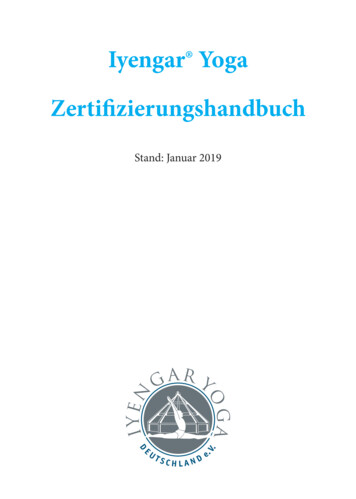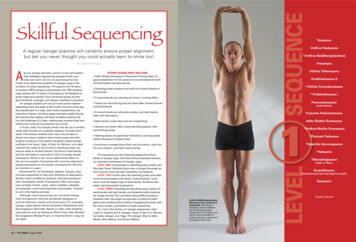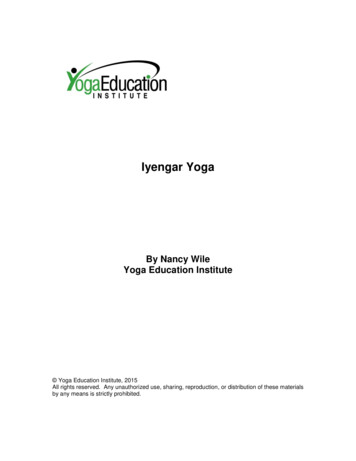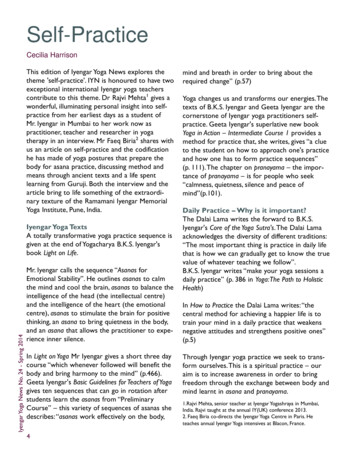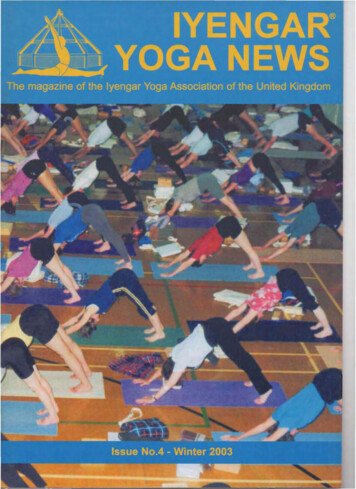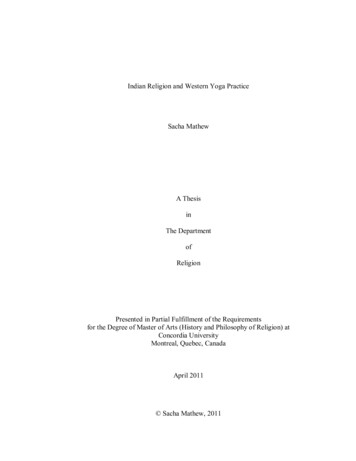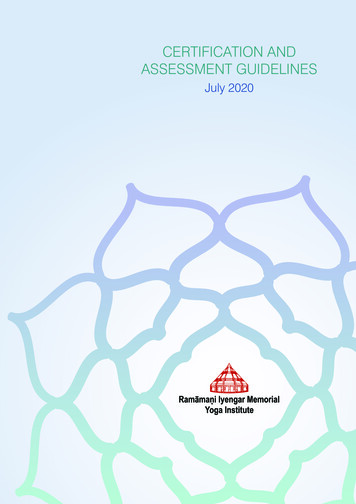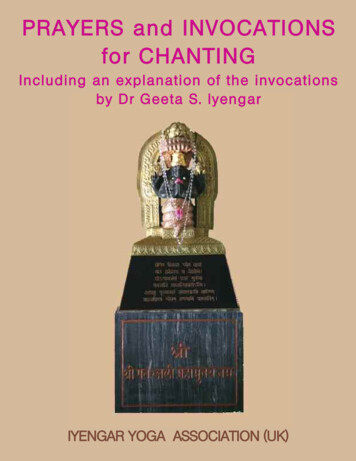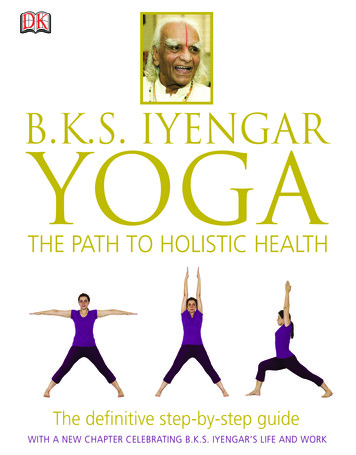
Transcription
B.K.S. IYENGARYOGATHE PATH TO HOLISTIC HEALTHThe definitive step-by-step guideWITH A NEW CHAPTER CELEBRATING B.K.S. IYENGAR’S LIFE AND WORK
B.K .S. IYENGARYOGATHE PATH TO HOLISTIC HEALTH
London, New York, Melbourne,Munich, DelhiORIGINAL 2001 EDITION: Consultant Dr Geeta S. Iyengar, Project Editor Ranjana Sengupta, Project Designer Aparna Sharma,Editors Dipali Singh, Sheema Mookherjee, Designers Ankita Saha, Nikki Duggal, DTP Designer Sunil Sharma,Managing Editor Prita Maitra, Managing Art Editor Shuka JainREVISED 2008 EDITION: DK UK Senior Art Editor Isabel de Cordova, Senior Editor Jennifer LathamDK INDIA Design Manager Arunesh Talapatra, Designers Neha Ahuja, Ivy Roy, Mahua Mandal,DTP Designers Govind Mittal, Pushpak Tyagi, Editorial Team Dipali Singh, Alicia Ingty, Aditi Ray, Saloni Talwar,Head of Publishing Aparna SharmaUPDATED 2014 EDITIONDK UK Project Editors Elizabeth Yeates, Angela Baynham, Senior Designer Tessa BindlossManaging Editor Dawn Henderson, Managing Art Editor Christine Keilty, Senior Jacket Creative Nicola PowlingJacket Design Assistant Rosie Levine, Producer, Pre-Production Sarah Isle, Senior Producer Oliver JeffreysArt Director Peter Luff, Publisher Peggy Vance DK UK Senior Editor Shannon Beatty Editor Jane Perlmutter DK INDIA SeniorArt Editor Ivy Roy, Editor Janashree Singha, Art Editors Sourabh Challariya, Gazal Roongta,Vikas Sachdeva, Neha Wahi Managing Art Editor Navidita Thapa, Deputy Managing Editor Chitra SubramanyamPre-Production Manager Sunil Sharma, DTP Designers Satish Chandra Gaur, Anurag TrivediProduction Manager Pankaj Sharma, DTP Designers Nand Kishor Acharya, Arvind KumarYoga Consultant Zarina MubarakiAuthor’s Acknowledgments B.K.S. Iyengar would like to thank Dr Geeta S. Iyengar for her expert advice as a consultant,contribution to editing the script, and assisting with the photography; Parth Amin, producer of the CDs Yoga for You and Yoga for Stress,for his ideas, and perseverance in completing the book; Roshen Amin, Stephanie Quirk, and Uma Dhavale for their contributions; ProfessorR.N. Kulhali, for drafting and compiling the Yoga text; Harminder Singh for the photography; and models Roshen Amin, Leslie Peters,Ali Dashti, and Jawahar Bangera.First American edition, 2001This revised edition, 2014Published in the United States byDK Publishing345 Hudson Street, 4th FloorNew York, New York 1001414 15 16 17 18 10 9 8 7 6 5 4 3 2 1001–196650 – Jan/2014Copyright 2001, 2008, 2014 Dorling Kindersley LimitedText copyright 2001, 2008, 2014, Kirloskar Computer Services Limited Text and Images copyright for Chapter 1 (pp8–33) 2014 B.K.S. IyengarCopyright in all photographs 2001, 2008, 2014 Kirloskar Computer Services Limited with the exception of those listed in the acknowledgments.All rights reservedPUBLISHER’S NOTE Neither the publisher nor the author is engaged in rendering professional advice or services to the individual reader.The ideas, procedures, and suggestions contained in this book are not intended as a substitute for consulting with your physician. Allmatters regarding your health require medical supervision. Neither the author nor the publisher shall be liable or responsible for any lossor damage allegedly arising from any information or suggestion in this book.Without limiting the rights under copyright reserved above, no part of this publication may be reproduced, stored in or introduced into aretrieval system, or transmitted, in any form, or by any means (electronic, mechanical, photocopying, recording, or otherwise), without theprior written permission of both the copyright owner and the above publisher of this book.Published in Great Britain by Dorling Kindersley Limited.A catalog record for this book is available from the Library of Congress.ISBN 978-1-4654-1583-7DK books are available at special discounts when purchased in bulk for sales promotions, premiums, fund-raising, or educational use.For details, contact: DK Publishing Special Markets, 345 Hudson Street, 4th Floor, New York, New York 10014 or SpecialSales@dk.com.Color reproduction by Colourscan, SingaporePrinted in China by South ChinaDiscover more at www.dk.com
B.K .S. IYENGARYOGATHE PATH TO HOLISTIC HEALTH
Contentsforeword6Chapter 1B.K.S. Iyengar’S LIfe and WorK 8Iyengar the Guruthe Iyengar Approach to Yogathe Iyengar LegacyMessage from B.K.s. Iyengar10162432Chapter 2yoga for you34Aims of Yogathe Way to HealthBenefits of PosesYoga and stressYoga and Fitness3639404142Chapter 3phILoSophy of yoga44Meaning of YogaPhilosophy of Asanasstate of Mindeight LimbsChakrasthe Guru and the Yogi464850525658Chapter 4aSanaS for you60Classic Poses62Standing asanastadasanaUtthita trikonasanaVirabhadrasana 2Utthita ParsvakonasanaParsvottanasanaAdhomukha svanasanaUttanasanaVirabhadrasana 1666870768084889296Sitting orward BendsJanu sirsasanatrianga onssalamba sirsasanasalamba sarvangasanaHalasana136138144150Back BendsUstrasanaUrdhva Dhanurasana154156160reclining asanassupta Virasanasavasana164166170118122Chapter 5yoga for StreSS174Understanding stressthe Modern WorldFood and nourishment176177178
Positive and Negative StressAsanas and StressAsanas with PropsPropsAsanas for stressTadasana SamasthithiTadasana UrdhvaHastasanaTadasana UrdhvaBaddanguliasanaPaschima BaddhaHastasanaTadasana PaschimaNamaskarasanaTadasana GomukhasanaUtthita TrikonasanaUtthita ParsvakonasanaArdha ChandrasanaUttanasanaPrasarita PadottanasanaAdhomukha SvanasanaDandasanaVirasanaUrdhvamukha JanuSirsasanaBaddhakonasanaSwastikasanaParipurna NavasanaUpavista KonasanaPaschimottanasanaAdhomukha PaschimottanasanaJanu SirsasanaAdhomukha VirasanaAdhomukha SwastikasanaBharadvajasanaMarichyasanaUtthita MarichyasanaParsva VirasanaSalamba SarvangasanaHalasanaViparita KaraniSetubandha SarvangasanaViparita 22223225226228230232234236238240Supta PadangusthasanaSupta BaddhakonasanaSupta VirasanaSavasana242244246248CHAPTER 6PRAnAyAmA wITH PRoPs250The Importance of PranayamaUjjayi PranayamaViloma 2 Pranayama252254256CHAPTER 7yoGA foR AILmEnTs258Yoga TherapyHeart and CirculationRespiratory SystemDigestive SystemUrinary SystemHormonal SystemImmune SystemMuscles, Bones, and JointsSkinBrain and Nervous SystemMind and EmotionsWomen’s HealthMen’s ER 8Iyengar yoga Course406Guide to your Yoga Practice20-Week Yoga Course408410Anatomy Guide424Glossary426List of Asanas427Index428Acknowledgments432Useful Addresses432
Forewordby Yogacharya B.K.S. IyengarYoga is for everyone. You need not be an expert or at the peak of physicalfitness to practice the asanas described in this book. The strain of modernlife can lead to physical pain and illness, as we neglect our bodies in therace for material success. The stress of modern life can also lead to mentalsuffering: feelings of inadequacy, isolation, or powerlessness. Yoga helpsto integrate the mental and the physical plane, bringing about a sense ofinner and outer balance, or what I term alignment. True alignment meansthat the inner mind reaches every cell and fiber of the body.During seventy-three years of teaching and practicing, I have observedthat some students pay attention only to the physical aspect of yoga. Theirpractice is like a fast-flowing stream, tumbling and falling, which lacksdepth and direction. By attending to the mental and spiritual side, a sincerestudent of yoga becomes like a smoothly flowing river which helps toirrigate and fertilize the land around it. Just as one cannot dip into the sameriver twice, so each and every asana refreshes your life force with new energy.My effort in this book has been to focus on techniques, so that even thebeginner will have a thorough understanding of how to practice asanasin order to obtain the maximum benefit. By using a few simple props,students with different capabilities can gradually build up strength,confidence, and flexibility without the threat of strain or injury. The yogatechniques described and illustrated in this book can also help those withspecific ailments. Regular practice builds up the body’s inner strength andnatural resistance, helps to alleviate pain, and tackles the root, rather thanthe symptoms, of the problem. Across the world, there is now a growingawareness that alternative therapies are more conducive to health thanconventional ones. It is my hope that this book will help all those who wantto change their lives through yoga. May yoga’s blessing be on all of you.
chapter 1Life andWork“When I practice, I am a philosopher.When I teach, I am a scientist.When I demonstrate, I am an artist.”It is almost impossible to contemplate the art of yoga without considering thecontribution of the revered yoga master, B.K.S. Iyengar. From humbleand inauspicious beginnings, Iyengar displayed a truly remarkable fortitude anddetermination to improve his situation and health through the art of yoga. Hisgenius and insight into mastering and defining the ancient practice has popularizedyoga today, making it accessible to millions all over the world and allowing themto discover the enlightenment of spirit enjoyed in the life of a dedicated yogi.
Iyengar the guru 11Iyengar the GuruB.K.S. Iyengar triumphed over poverty and childhood ailments to master andrevolutionize the art of yoga. Credited with bringing yoga to the West, he hasalso made it accessible to millions of people all over the world.The path to greatness, to becoming a legend, isstrewn with disappointments, failures, and anxieties.Enduring and surviving testing times demandsunrelenting persistence, dedication, and focus. B.K.S.Iyengar, who has been awarded two of India’s greatestcivilian awards, the Padma Shri and Padma Bhushan,remembers such times. Today, he is living testament tothe triumph that can follow adversity.“After many strides forward, when one looks back,things seem to fit,” says Mr. Iyengar. He is at theRamaamani Iyengar Memorial Yoga Institute in Pune,India, waiting for a cup of coffee. It is late afternoonand the evening classes are about to begin. The studentsare trooping in, but stop when they spot their gurusitting near the office. They sit down on the floor, tolisten; it isn’t often that you get to hear a legend talkabout his life, his successes, and his journey towardconquering the body, intellect, and mind.At 95 years old, B.K.S. Iyengar is a living legend;a simple man who sought to master and immortalizethe ancient discipline of yoga, and became a guru.His rise to success can only be described as an act ofstrong willpower, extreme perseverance, burningdetermination, and sheer obstinacy.Humble beginningsBellur Krishnamachar Sundararaja Iyengar was bornon December 14, 1918, in the tiny village of Bellur,close to Bangalore, a city that is now India’s IT hub. He(top) B.K.S. Iyengar adjusting his son Prashant’s posture whilehe does the Vrschikasana (Scorpion pose), 1960–1961.(left) B.K.S. Iyengar at the ramaamani Iyengar Memorial yogaInstitute in Pune, 2008.was a sickly child with thin arms and legs, a protrudingstomach, and a heavy head. “My appearance was notprepossessing,” Mr. Iyengar says. His father died in1927, when he was eight, leaving the family in absolutepoverty. “There was a time when we couldn’t pay theschool fees and I was not allowed to sit the exams.My brother took me begging for money,” he recalls.Despite his present successes, he clearly remembersthese challenges from the past. “Poverty acted as agarland for knowledge. If I hadn’t been born into sucha poor family, I probably wouldn’t have gained anything.I am grateful that poverty followed me for years.Knowledge was born from this poverty.”Introduction to yogaIn 1934, Mr. Iyengar received an offer he couldn’trefuse from Tirumalai Krishnamarcharya, a respectedyoga scholar, who was married to his sister Namagiri.Krishnamarcharya, considered the father of modernyoga, ran a yoga school at the Jaganmohan palaceof his patron, the Maharaja of Mysore. He asked Mr.Iyengar to move to Mysore to help Namagiri withhousehold chores, securing his destiny.Krishnamarcharya was a taskmaster. “I don’t thinkhe saw any real potential in me. He told me to practiceasanas to improve my health,” Mr. Iyengar says. “Ijumped at the offer. Health had been a perennialproblem for me since I was born.” It took three yearsof practicing yoga before Mr. Iyengar noticed a distinct
12 life and work“An inner voice urged me to persist andcarry on. My will alone held on.”B.K.S. Iyengar (extreme right) with his guru ProfessorTirumalai krishnamarcharya (center) and the Prince of Mysore(second from left) in the early days (1937).change in his health and this encouraged him. “Myguruji (Krishnamarcharya) barely paid me anyattention during this time. Later, he taught me justthe outline for the basic asanas—the classic yogapostures. I grasped the rudiments of each asana andpracticed on my own. I learned the difficult postures,such as Vrschikasana (Scorpion pose) and handbalancing, during the public performances we usedto participate in! I don’t know what Guruji really sawin me, but I think he recognized that I had guts.”In 1935, the Maharaja of Mysore arranged a yogademonstration. Mr. Iyengar was getting ready topresent some of the asanas, but Krishnamarcharyathrew him a challenge. He asked Mr. Iyengar toperform the Hanumanasana (Great Split, where thelegs are split forward and backward). “I had noknowledge of this asana. My guru described the poseand I realized it was difficult. I told Guruji that myshorts were too tight. It would be difficult to stretch mylegs. He asked one of his senior pupils to cut the shortson each side with a pair of scissors. Then he told me todo the asana. I did it, but with a resulting tear in myhamstring that took years to heal. Guruji wasimpressed and asked me how I had managed it. Hetold me that he didn’t think I would be able to do it,but I did. The token I received from the Maharaja ofMysore was nothing compared to those words ofpraise from my guruji.”The beginnings of Iyengar yogaMr. Iyengar with his wife Ramaamani in 1960. She becamehis student and one of his strongest supporters.“I learned a valuable lesson that day. I realized thatattempting certain asanas suddenly, without preparation,could harm the body and the mind. I started evolvingthe asana sequences scientifically. I developed aprogressive approach from simple to difficult asanas. Icategorized them by their effects, as being purifying,pacifying, stimulative, nourishing, or cleansing. Gurujilit the fire of yoga within me. But I did not learn it inthe form that it is today. I struggled with and traced themissing links of refinement and precision. I evolvedmy guru’s method, so that a set of asanas could bepracticed followed by another set, using the alignmentof the intelligence in the asanas,” Mr. Iyengar says.Krishnamarcharya had made an indelibleimpression on Mr. Iyengar. “In our wheel of yoga, hewas the hub. We, as spokes, rolled the wheel without
Iyengar the guru 13(left) An early family portrait of B.K.S. Iyengarand ramaamani with their children, 1959.creating bends or dents in it. Unfortunately for allhis intellectual progress, his ways and moods wereunpredictable. We were afraid to talk to him, letalone question him. Yet his conduct, firm discipline,perseverance, vast knowledge, and powerful memoryleft a permanent mark on our lives.”Teaching while learningIn 1936, the Maharaja of Mysore sent Krishnamarcharyaand his students on a lecture tour across the state ofpresent-day Karnataka. Soon after this Dr. V.B. Gokhale,a well-known surgeon, asked Krishnamarcharya to senda student to the Deccan Gymkhana Club in Pune, toteach yoga for six months. Mr. Iyengar was 17 andspoke a little English, although he couldn’t speakMarathi, the local language. However, he was deemedthe obvious choice. “Besides the language barrier, thecollege students often made fun of me as they wereolder and better educated,” he says. “I suffered from aninferiority complex because of my shendi (tuft of hair,typical of orthodox Hindu Brahmins). But I decided Iwould not be dejected. I worked hard to prove yoga’sworth.” Mr. Iyengar’s term at the Club was extendedevery six months for a period of three years.The years that followed would prove to be thedarkest period in Mr. Iyengar’s life. He lost his job at theDeccan Gymkhana Club and with the exception of twoor three students, his teaching had practically cometo a full stop. “It was a testing time of tears, failures,and anxieties. In hindsight, it seems that this wasthe darkest hour before the dawn of prosperity,”Mr. Iyengar says.“ An inner voice urged me to persistand carry on. My will alone held on. I practicedintensely and taught yoga to whoever was interested. Icycled miles to reach students’ houses. There weredays when I survived on tap water, as everything elsewas unaffordable. I had no guarantees, no help, and nosupport from my family. Failures gave me determinationand showed me a new light and a fresh way to progress.I used the tool of disappointment as an appointmentfor a new assignment. Failures, stalemates, anddisappointments strengthened my will to pursuethis path of yoga with determination, and Godgraced me in my path.”Amidst this struggle for sustenance and recognition,Mr. Iyengar married Ramaamani in 1943. “My financialB.K.S. Iyengar felicitates t. Krishnamarcharya onthe occasion his 60th birthday.
14 life and work(right) A young Geeta Iyengar, iyengar’s daughter,practices the Virabhadrasana 2 (warrior pose 2).position was dire, but family pressure prevailed andwe were married against my better judgement. Wecelebrated our marriage on borrowed money,” he says.Ramaamani was unfamiliar with yoga in the beginning,but she soon became a dedicated student. “She wasquick to help me in my practice. She developed sensitivityand a healing touch. Without Ramaa it is possible thatmy method of yoga and myself would not be what weare today,” he says. “I used to tell Ramaa to observe myposture while I practiced yoga, and to correct me.She was my mirror to achieve accurate form.”There is no doubt, Iyengar says, that Ramaasacrificed her dreams so that he could pursue his art.“When I left my family to teach in Europe and theUS, she faced many problems. For examle, there weremassive floods in Pune in 1962, and people rushed totheir terraces with their possessions. But Ramaa’s soleconcern was to keep safe the manuscript for my bookLight on Yoga.”The rise of Iyengar yogaGradually, the number of students who wanted tolearn from Mr. Iyengar increased. After he helped ayoung girl recover from polio of the spinal column,word of B.K.S Iyengar’s healing touch spread, too,both locally and within the medical community.The turning point, he says, came in 1946 when bothMr. Iyengar and his wife had similar dreams of divinity.“From that night on, fortune favored us. Peoplesuffering from various diseases started coming tome for relief,” he says.It was around this time that Mr. Iyengar wasintroduced by a student to Jiddu Krishnamurthi, oneof India’s greatest philosophers. Mr. Iyengar, however,hadn’t heard of Krishnamurthi. “I hadn’t read hisbooks and I didn’t know he was one of the greatestthinkers in the 20th century, but I started to attendhis lectures in Pune. He was fond of saying, ‘Do notcriticize and do not justify.’ He taught me not to bedisturbed or swayed by people’s opinions. Yogis allover the world criticized me for doing what theyconsidered ‘physical yoga.’ I was very clear about whatI practiced. I never felt the need to justify what I wasdoing. Even now, I do not bother about other people’sremarks, but instead focus on evolving my ownpractice. Nor do I criticize others or their systems.B.K.S. Iyengar with the famous philosopher Jiddu krishnamurthi(right) who became a loyal student, 1955.
iyengar the guru 15“A fortuitous meeting with Lord Yehudi Menuhinin 1952 introduced the world to Iyengar yoga.”Krishnamurthi paid me a great compliment whenhe wrote, ‘You have taught me yoga for 20 years—whenever someone asks me who is the greatest yogateacher, I always send him or her to you.’”Iyengar’s dream of making yoga popular, however,was reaching a critical juncture. It was a fortuitousmeeting with celebrated violinist Lord Yehudi Menuhinin 1952 that introduced the world to Iyengar yoga.Menuhin was in Bombay and was due to meet Mr.Iyengar but almost canceled the meeting. “I understoodthe state of his mind and persuaded him to give mefive minutes. I made him lie in Savasana (a recliningasana that helps recover the breath and cool the bodyand mind—see pages 170–172). In that lying position,using my fingers, I guided him in Shanmukhi mudra(the placement of fingers in a particular position on theface to block out the senses). He fell asleep for almostan hour!” says Mr. Iyengar.“I had never heard of him before. I soon realizedthat he was a celebrity, but to me he was anotherhuman being with a physical ailment that I couldcure,” he says. Menuhin was exhausted and sufferingfrom hyperextension of the bow arm. Guided by Mr.Iyengar, his condition improved quickly. He was sopleased that he gave Mr. Iyengar a watch with theengraving, “To my best violin teacher.”Mr. Iyengar gives a BBC tV interview with nigel green (far right), 1962.Tackling misconceptionsThat five-minute interview blossomed into a lifelongfriendship. Menuhin invited Mr. Iyengar to his home inGstaad, Switzerland, and later to London, introducinghim in Europe and the United States. Iyengar yoga wasall set to take off, but this was a difficult time in whichto introduce and establish the form. Mr. Iyengardiscovered this during his visit to London in 1954.“When I arrived at Victoria Station, the customsofficers asked me my profession. When I said yoga,they asked me whether I could walk on fire, chewglass, or swallow blades! Yoga was unknown in theWest and the Occidental concept of yoga was next tonothing,” he says. Menuhin introduced him to friendsinterested in learning the form. “It was a tough time.Everyone is interested today, but then it was difficultfor any yoga practitioner to teach the local people.Yoga was not respected. A lot of people saw me as acolored man from a former British colony. I faced aViolinist Yehudi Menuhin (left) learned yoga from Mr. iyengar,1956. But the yogacharya considers Menuhin his guru in the artof Pranayama (the yogic practice of breathing).
16 life and work“The tree is still spreading. The winds of yogaare blowing everywhere.”B.K.S. Iyengar gives a demonstration at the Jewish Societyduring one of his earliest trips to london, 1963.B.K.S. Iyengargives a public performanceto an enthralled audiencein Japan, 1984.B.K.S. Iyengar with His HolinessPope Paul Vi at the Vatican inaugust, 1966.certain amount of discrimination in the early days in theUK and the US. Yet, at the same time, there were peoplewho showed me a lot of hospitality and friendship.”Mr. Iyengar started by giving demonstrations in barsor any other place where people gathered and showedinterest. “People smoked and drank in my presence.I changed them slowly. I did not demand respect. Iearned it. In time, they sought permission to drink wineat the table. Later, they stopped smoking or drinking. Itwas not a sudden transformation. I was tolerant. Myinner voice told me not to criticize. I had gone thereto propagate yoga.” Mr. Iyengar traveled to the US in1956 at the invitation of Menuhin’s friend RebekahHarkness, the Standard Oil heiress. His demonstrationswere, however, confined to the Harkness family andtheir friends. It would take more than 18 years forIyengar yoga to finally make an impact in America.One of Mr. Iyengar’s key encounters took place in1958 when he met and taught Queen Elisabeth ofBelgium. The Queen was 84 when she invited Iyengarto teach her yoga. “I began with simple standing posesand the Halasana (Plough Pose—see pages 150-153).She was not willing to stop. She wanted me to teachher Salamba Sirsasana (Headstand—see pages 138-143).She was frail and I knew by looking at her that she hadproblems with her heart. When I asked for her medicalreports, she said, ‘Sir, if you have faith in yoga, whydo you want my medical reports? If you are afraid ofteaching me the head balance, then you can take thenext train to Gstaad, and join your friend Yehudi whorecommended you!’ I appreciated her courage andpersistence. I told her, ‘If you have the courage to dothe head balance, I have the courage to teach you.’After she did the head balance, I taught her asanas tobring her blood pressure down,” he says. Mr. Iyengarcontinued to teach the Queen until her death in 1965.Yoga for the peopleMr. Iyengar returned to London in 1960, again on theinvitation of Menuhin. This time he wanted to teacheveryone and not just celebrities. Menuhin arrangedclasses for him through the Asian Musical Circle,founded by Mr Ayana Deva Angadi, an Indian settled inLondon. In the beginning, there were only four studentsand lack of funds had him turn the backyard of Angadi’shouse into a classroom. But slowly his practical
Iyengar the guru 17(left) B.K.S. Iyengar teaching a class atann arbor in Michigan, 1973.demonstrations attracted more people.Iyengar yoga made an important cultural crossover in1966 when Mr. Iyengar met His Holiness Pope Paul VI. “Iwas blessed to have an audience with him. Both of usdiscussed the subject of yoga. It was one of the happiestmoments of my life. The Pope caught my hands andblessed my good work. His Holiness praised me with thewords, ‘You are a professor and director of yoga. I blessyou with all my heart and am happy to have met you.’”This was also the time when Mr. Iyengar’s bookLight on Yoga was first published. It was an instantclassic, drawing people to the art of yoga. Menuhinwrote in the foreword, “Whoever has had the privilegeof receiving Mr. Iyengar’s attention, or of witnessingthe precision, refinement, and beauty of his art, isintroduced to that vision of perfection and innocencewhich is man as first created.” The book became aninternational bestseller and has since been translatedinto 18 languages. It is often called “the bible of yoga.”The Ramaamani Iyengar Memorial InstituteYoga was finally making an impact across the world.Students started traveling to Pune to learn the form fromMr. Iyengar and his wife Ramaamani recognized theneed to create a yoga school. Mr. Iyengar used proceedsfrom Light on Yoga to buy a plot of land in Pune. Butthree days after the inauguration in January 1973,Ramaamani became ill and died. Work continued and theinstitute finally opened its doors to students in 1975.“Though she is no more, I am never separated from her—for she is always in my heart. The Ramaamani IyengarMemorial Yoga Institute is my tribute to her,” he says.Today, thousands of Iyengar students arrive atthe Institute to study his unique concept of yoga andto imbibe his rigorous discipline. “I began with twostudents. Today, millions are practicing yoga,”Mr. Iyengar says. “My students teach in schools,colleges, yoga centers, and sports clubs in major UScities. Yoga has breached Apartheid with many SouthAfrican students attending my classes in London in theearly 1960s. I have students in practically everyEuropean nation, as well as Russia and China. The treeis still spreading. The number of students influenced bymy teaching is impossible to know, but it is certainly inthe hundreds of thousands. The winds of yoga areblowing everywhere.”B.K.S. Iyengar being greeted and welcomed by followers in China,in 2011. his books have all been translated into Mandarin.
the iyengar approach to yoga 19The Iyengar Approach To YogaIyengar yoga is a holistic experience that benefits the body, mind, and emotions.The driving force behind Iyengar yoga is B.K.S. Iyengar’s belief that yoga is foreveryone, and that it is effective in reducing modern-day stress.In the early days, while practicing and teaching yoga,B.K.S. Iyengar experienced an inner dryness. Hequestioned its persistence since he knew his techniquewas correct, and used his body and intelligence tostudy himself while practicing. His inner consciousnessbecame his guru. He learned that while practicing anyasana, it is important for the body and its organs towork or move in a certain way, without leaving theiralignment. He penetrated the organic body by closelyexamining his outer body, the skin’s movement, and thealignment of his physical body. He discovered thatperfect symmetry removed undue stress and restoredthe organic and cellular body to its original state ofhealth. The inner dryness disappeared.As Mr. Iyengar observed his inner organic bodyin different asanas, he felt various channels (nadis)open from within. These channels allowed the energy(prana) to flow, spread, and circulate in every partof the body including the nerves, skin, and brain.He attained a feeling of alignment, sensitivity, andintelligence. This process of performing each asanawith microscopic awareness, self inquiry, and mindand body feedback brought a revolution in Mr.Iyengar’s practice and, in turn, his teaching.Aligning the selfMany yoga practitioners are flexible and practice asanasin a habitual manner, without involvement or reflection.Mr. Iyengar teaches his students to understand thatasanas are not just about the movement of the physicalbody; there has to be a microscopic awareness and(top right) A young B.K.S. iyengar.(left) Mr. Iyengar, age 24, practicing the pari purnaMatsyendrasana (complete Lord of the Fishes pose).inner penetration, so that the asana becomes an asanain the real sense. He realized that there is an instrumentof awareness in everybody. The average yoga studentis aware of his or her body with respect to the asana’stechnique and outline. However, most do not u
Contains specially developed yoga sequences to help alleviate more than 80 ailments, from asthma and arthritis to irritable bowel syndrome and diabetes Take a master class from B.K.S. Iyengar—one of the world’s greatest yoga teachers—and change your life. Iyengar Yoga is, globally, the most practiced
